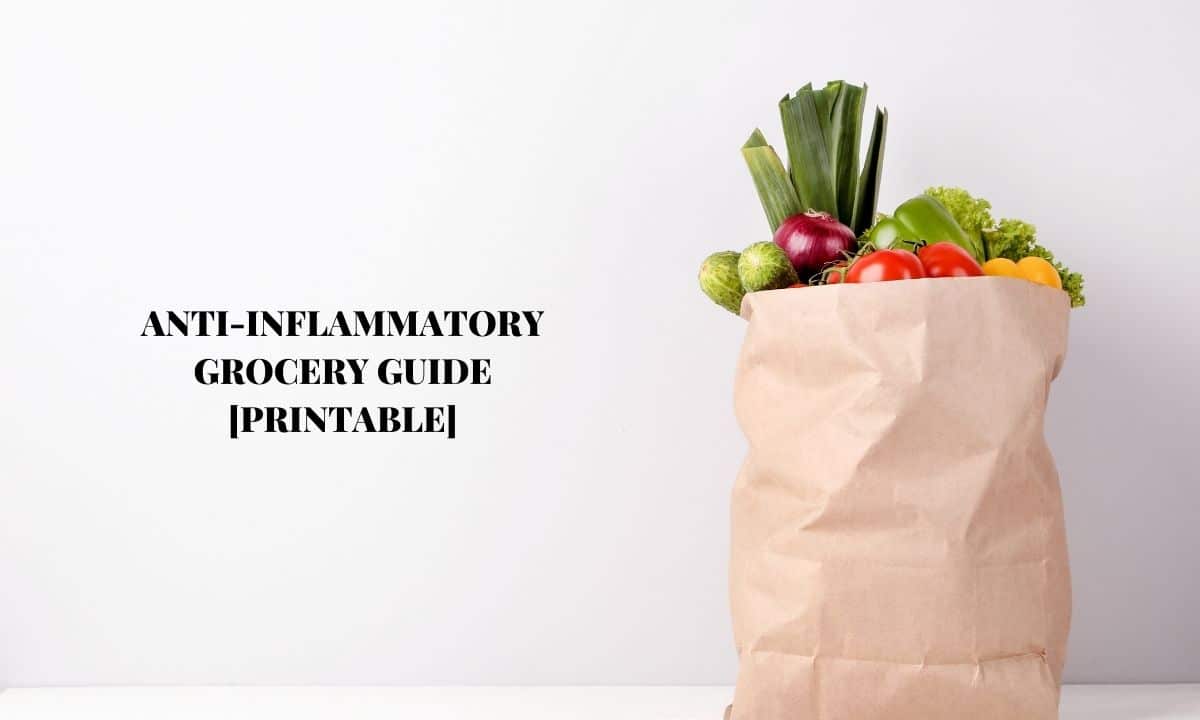Nourish & Thrive: Anti-Inflammatory Grocery Guide [Printable]
Adopting an anti-inflammatory diet can provide numerous health benefits. Eating foods rich in nutrients and antioxidants can reduce inflammation, improve the immune system, and lower the risk of chronic diseases.
Table of Contents
ToggleMoreover, this type of diet can aid in maintaining a healthy weight and promoting optimal gut and brain health.
With its emphasis on whole foods and limiting processed items, an anti-inflammatory diet also contributes to better energy levels and overall mood enhancement.
Creating Your Anti-Inflammatory Grocery List
Creating an anti-inflammatory grocery list can seem daunting at first, but it’s easier than you might think. Here are some tips for shopping:
- Prioritize fresh, whole foods over processed items
- Include a variety of colors to ensure a wide range of nutrients
- Opt for organic options when possible to reduce exposure to pesticides
- Plan meals and snacks ahead of time to avoid impulsive purchases
- Limit foods high in sugar and saturated fat
Anti-Inflammatory Grocery List [Printable]
Please download your pdf below.
Foods to Include
| Cruciferous vegetables | Broccoli, Brussels sprouts, red and green cabbage, and cauliflower |
| Leafy green vegetables | Arugula, collard greens, dandelion greens, kale, mustard greens, spinach, and Swiss chard |
| Deep yellow or orange vegetables | Acorn squash, butternut squash, carrots, orange and yellow bell peppers, pumpkin, and sweet potatoes |
| Other vegetables | Mushrooms, tomatoes |
| Fruit | Apples, apricots, blackberries, cherries, grapes, pineapple, strawberries, oranges, mandarins, grapefruit, peaches, plums, pomegranates, raspberries, and watermelon |
| Protein | Lean turkey, chicken, and fatty fish (salmon, sardines, herring, mackerel) |
| Legumes | Navy beans, kidney beans, pinto beans, black beans, and other dry beans; also, chickpeas, green peas, lima beans, and lentils |
| Whole Grains | Gluten-free oats, buckwheat*, millet, quinoa, brown and wild rice |
| Nuts and Seeds | Almonds, cashews, chia seeds, hazelnuts, hemp seeds, pecans, walnuts, and flaxseed |
| Healthy Fats | Avocados, avocado oil, coconut oil, MCT oil, extra virgin olive oil |
| Herbs and Spices | Cinnamon, nutmeg, turmeric, ginger, garlic, cayenne, black pepper, basil, oregano, cumin, thyme, clove, and cinnamon |
| Tea | Green and herbal tea |
| Chocolate | Dark chocolate (unsweetened) |
Despite having the name wheat, buckwheat is gluten-free
Foods to Limit or Avoid
| Processed Meats | Sausage, deli meats, hot dogs, hamburgers, and other processed meats |
| Fast Foods | All types of fast food and takeout food |
| Processed Snacks | Beef jerky, pretzels, chips, crackers, tortilla chips, and sandwich crackers |
| Oils | Processed seed oils and vegetable oils, safflower oil |
| Trans Fats | Products with partially hydrogenated oils, including commercial baked goods such as cakes, cookies, and pies; shortening, fried foods, and some margarine |
| Refined Carbohydrates | White pasta, white bread, white flour, sugary breakfast cereals, pastries, and pizza |
| Breakfast Sweets | Pastries, doughnuts, croissants, sugary cereal bars, and sweet rolls |
| Desserts | Brownies, candy, cake, ice cream, cookies, pies, and other desserts |
| Sugary Drinks | Soda, cola, fruit drinks and punches, lemonade, energy drinks, and other drinks with added sugar |
| Alcohol | Wine, beer, spirits, cocktails, and especially alcohol mixed with sugar |
Tips for a Successful Anti-Inflammatory Diet
Incorporating an anti-inflammatory diet into your lifestyle doesn’t have to be difficult — all it takes is a little planning. Here are some tips for success:
- Schedule time each week to meal plan and shop for groceries
- Choose real, unprocessed foods most of the time
- Make sure your meals are balanced with lean protein, healthy fat, complex carbohydrates, and plenty of fruit and vegetables
- Drink plenty of water throughout the day
- Get creative in the kitchen and try new foods, recipes, and flavors
- Don’t forget to treat yourself occasionally. A piece of dark chocolate or a glass of wine can be part of a healthy lifestyle
- Gradually eliminate or reduce foods that are high in trans fats, refined sugars, and processed ingredients.
- Monitor your body’s response and consult a healthcare professional if needed
With these tips in mind, you’ll be sure to find success on your anti-inflammatory journey.
Helpful Resources
Get your free 3-day anti-inflammatory diet plan
From the blog:
Anti-inflammatory recipes:
The Bottom Line
Inflammation is a natural part of the body’s immune response, but it can have serious health consequences when it becomes chronic.
Diets designed to fight inflammation have been shown to reduce inflammation and improve overall health. This diet focuses on eating real, unprocessed foods in balance with plenty of fruit and vegetables while limiting or avoiding certain unhealthy foods.
With a bit of planning and creativity, adopting an anti-inflammatory diet can be a great way to improve your health and well-being.
Happy shopping — and bon appétit!
Meta Description
An anti-inflammatory grocery list includes a variety of fresh, whole foods and a range of colorful fruits and vegetables.

Dr. Su-Nui Escobar, a Registered Dietitian/Nutritionist in Miami, FL, is dedicated to empowering women in perimenopause and menopause to live healthier, more satisfying lives.
With a doctorate in clinical nutrition from the University of North Florida, she has expertise in menopause and weight loss, including the unique challenges faced by those on weight loss medications.
Su-Nui’s passion for her field is evident in her previous role as the Academy of Nutrition and Dietetics spokesperson.


